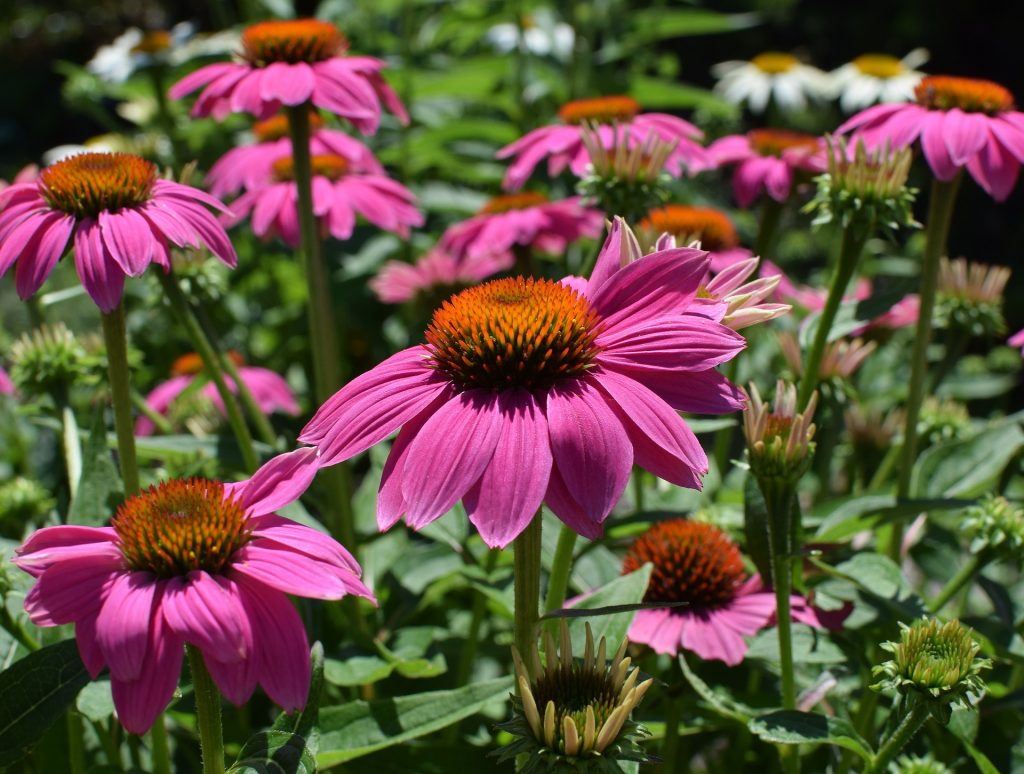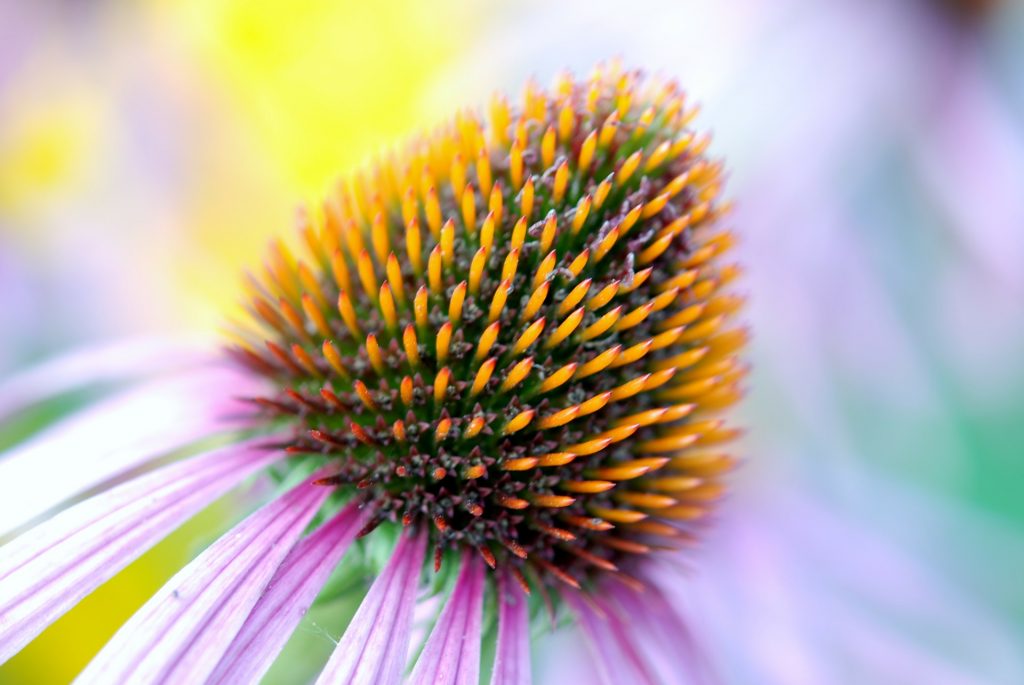 Echinacea generally refers to two plants, Echinacea purpurea or Echinacea angustifolia. Echinacea belongs to the Asteraceae or daisy family and is therefore closely related to the daisy and chamomile plants. Common names for echinacea include the coneflower. Echinacea is a perennial plant that grows to about 120 cm in height, and is characterised by a thin leaved stem, with purple or pink flower, central to which is a central disk of paleae which resembles a hedgehog (Ekhinos, the word from which Echinacea is derived is Greek for hedgehog). Echinacea is native to North America where it has been used as a traditional medicine by the Native American Indians. There is some debate as to whether Echinacea purpurea or Echinacea angustifolia should be used in supplement extracts, although there is no definitive answer to this and both appear to show similar medicinal properties. Further, there is some debate as to whether the root or aerial parts of the plant should be used, and again, both appear to have benefits.
Echinacea generally refers to two plants, Echinacea purpurea or Echinacea angustifolia. Echinacea belongs to the Asteraceae or daisy family and is therefore closely related to the daisy and chamomile plants. Common names for echinacea include the coneflower. Echinacea is a perennial plant that grows to about 120 cm in height, and is characterised by a thin leaved stem, with purple or pink flower, central to which is a central disk of paleae which resembles a hedgehog (Ekhinos, the word from which Echinacea is derived is Greek for hedgehog). Echinacea is native to North America where it has been used as a traditional medicine by the Native American Indians. There is some debate as to whether Echinacea purpurea or Echinacea angustifolia should be used in supplement extracts, although there is no definitive answer to this and both appear to show similar medicinal properties. Further, there is some debate as to whether the root or aerial parts of the plant should be used, and again, both appear to have benefits.

Echnicae extracts contain a group of phytochemicals called alkamides (also called alkylamides). The alkamides in echinacea extracts are similar to the endocannabinoid anandamide, which is synthesised and found in mammals. Evidence suggests that the alkamides in echinacea can interact with the CB1 and CB2 cannabinoid receptor in the brains of mammals and this may be how they exert their anxiolytic effects. The activation of the cannabinoid receptors, particularly the CB1 receptor, has been shown to be involved in the control of anxiety. Echinacea extracts may therefore contain phytocannabinoids that are able to exert their effects through interaction with the cannabinoid system in the brain of mammals.
The most well known medicinal use for echinacea extracts is as a modulator of the immune system. The plant contains a number of chemicals including polysaccharides, alkylamides (also called alkamides) and glycoproteins that may be responsible for the immune modulating and anti-inflammatory effects. A number of other chemicals have been isolated from echinacea extracts which may also explain their health effects. These include a large number of phenolic compounds that include flavonoids and hydroxycinnamic acids (including caffeic acid) and hydroxycinnamic acid derivatives (such as cichoric acid and rosmarinic acid). In addition, terpenoids, sesquiterpenes, lipids, nitrogenous compounds, alkaloids, carbohydrates, phytosterols, minerals and vitamins are also present in echinacea extracts. Many of these phytochemicals are thought to cross the blood brain barrier and so may act directly in the brains of mammals to confer their effects, which may explain the mood enhancing effects of echinacea.

Another mechanisms by which echinacea may reduce anxiety is through interaction with the transient receptor potential vanilloid-1 (TRPV1) receptors. Phytochemicals in echinacea extracts are able to inhibit the activation of this receptor, an effect which is thought to induce anxiolytic effects in mammals. Capsaicin in capsicum peppers has also been shown to inhibit this receptor, and this may explain the anti-anxiety effects of extracts of capsicum peppers.
For example in one study, a variety of different Echinacea purpurea preparations were shown to have consistent anti-anxiety effects in experimental rats exposed to stressful conditions such as maize tests. In another study, Echinacea angustifolia extracts were also shown to have significant anti-anxiety effects in rats, also exposed to stressful conditions. In this same study, Echinacea angustifolia extract as a 20 mg tablet, administered to humans for 1 week, was shown to cause a significant reduction in the anxiety rating of the subjects. However, higher doses were not effective. Both Echinacea purpurea and Echinacea angustifolia have therefore been shown to possess anti-anxiety effects in mammals including humans. Extracts of echinacea have been shown consistently to be very safe even for long term use. Many of the compounds in echinacea have been shown to be involved in mood regulation in other plants. This is particularly true for the flavonoids and terpenes, which are widely distributed throughout the plant kingdom.

Echinacea may also contain rosmarinic acid and caffeic acid (rosmarinic acid is a caffeic acid derivative). In animal models of anxiety, rosmarinic acid and caffeic acid have been shown to have anxiolytic effects. Both rosmarinic and caffeic acid are present in the herb rosemary, which may explain the anti-anxiety effects of this herb. Rosmarinic acid lowers anxiety through an unknown mechanism. Caffeic acid may lower anxiety through interaction with the α1A adrenoceptors, and thus may modulate adrenaline levels. Adrenaline release may be implicated in the triggering of certain types of anxiety. Echinacea also contains the caffeic acid metabolite chicoric acid. Chicoric acid may also exert some anti-anxiety effects due to structural similarities with caffeic acid and rosmarinic acid.
RdB
Eat Well, Stay Healthy, Protect Yourself
